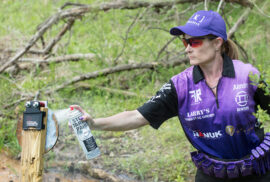
3 Steps for a D.I.Y. Gun Range
For most of us, owning a shooting range is a life goal. There’s something awesome about venturing out on the porch with the morning coffee in one hand and a suppressed .22 pistol in the other…pew…ping! Regular and instant access also makes gunsmithing work much easier, allowing verification of function and zero of repaired or customized guns on the spot. Compared to indoor ranges, an outdoor one is easier to set up, provided a few simple but vital steps are followed.
Legality
Step one is, of course, legality. Can you legally shoot on the property? In Florida, the answer is usually positive, provided you can do so safely. In New Jersey, it’s less likely. Check your local ordinances, possibly verify with a lawyer. If your range is used commercially, what licensing and EPA requirements would you have to meet?
Gun Range Safety
Step two is safety. How big is your backstop? Depending on the berm height and width, you may have limitations on where the shooter can stand, and on how low the firing position can be. At close range, shooter kneeling for stability could cause the target to pop up in front of the skyline instead of the berm. Your visitors might not know all the details, so mark the safe areas, or hand out a guide to your particular range.
Ricochets are also a factor: where do bounces off rocks go? Does lead splash off steel targets reach beyond the range boundaries? Can steel turn when hit, causing bullets to redirect intact at a shallow angle to visit neighbors?
Even if you sun completely with sound suppression, supersonic bullets are noisy in flight. Will you need to put up sound buffers to avoid disturbing neighbors and their dogs? Can you create noise buffers between shooting positions that do not just bounce the blast back at the shooter?
If the range faces low sun angle at some point during the way, what keeps the light from blinding the shooters? If possible, try to provide shooting positions with overhead cover against sun, rain, or snow — as much for the guns and the optics as for the shooters themselves. Set up a sandbox for weapon clearing, especially important for dealing with ammunition-related malfunctions.
Preparations and Precautions
Moving onto the more fun part: three types of targets would be useful. Zeroing and diagnostic targets are usually paper, so a target board is needed. Ideally, a range should have a target board for short range and long range at least. If you have 100 yards maximum, 10-25-100 would be a good split for pistol, shotgun, and rifle. If you have greater maximum distance, set up a board at the longest distance as well. To protect shooters changing targets downrange, a blinking red light above the bend to indicate a ceasefire is recommended.
While steel is far more expedient for regular shooting, zeroing and load development benefit from the finer resolution of paper targets. Hanging or post-mounted steel works great for tactical practice, either from the bend or in motion. Steel Target Paint is the industry standard for repainting steel between sessions: they come in many colors and give excellent coverage.
The targets do not have to be painted brightly: black works better for shooting with thermal sights, and camouflage patterns can be made to add realism in practice. In addition to lead splash, steel also gives audible and kinetic feedback when hit.
Outdoor ranges also allow for more improvised reactive targets: empty gallon milk jugs work well suspended. Several makers offer self-sealing plastic ground targets that roll away when hit, increasing the difficulty level with every shot. Avoid any targets that produce glass, plastic or metal shards, or anything flammable.
With all the shot-up material, it’s important to provide trash containers at the bench and in no-shoot downrange positions. That way, trash from wood post fragments to spent cases to shotshell wads can be collected daily. Offer a brass collection bag for people who do not retain their own cases for reloading.
Ready to have fun? If shooting in a group, designate the range officer to call going live and ceasefire. Know where the medical kit is, where the nearest ER is located, what the range address and GPS coordinates are, and who makes the call in case of an emergency. On the off-chance of a wildfire from a spark or a tracer ricochet, know both the location of fire extinguishers and the phone of the local fire department. Speaking of phones: is the range close enough to civilization to have cell coverage? If not, consider putting up an antenna with a repeater, or figure out an alternative to cell phones.
All preparations and precautions aside, have fun. And, to make the best use of the ammunition and the time, make plans for your range day. Are you making a dope chart, testing several loads for accuracy, practicing presentation from the holsters, or working on something else? While range time should be relaxing, especially for best long-range accuracy, competing against others is a great way to add adrenaline to the mix for more realistic defensive practice.
This is where dueling trees, Texas Star targets with plates painted two different colors, plate racks with overlapping last plates, and other direct competition targets really shine.
Be safe, have fun, learn something with every range trip — and don’t forget to bring in new shooters from time to time to grow the 2A community.
Written by: Oleg Volk, Firearms Photographer

